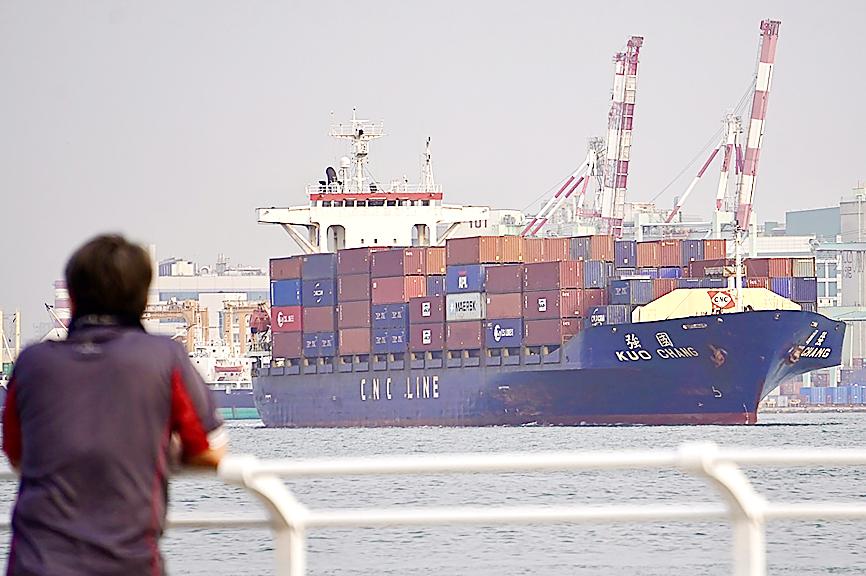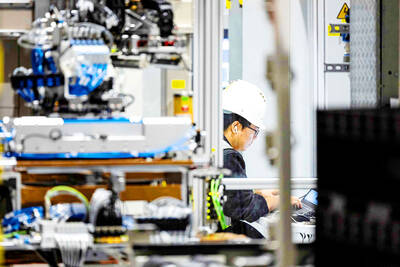Exports last month soared 27.1 percent year-on-year to a record US$35.89 billion, as inventory demand for all product categories gained unprecedented traction amid component shortages and shipping delays, the Ministry of Finance said yesterday.
The growth momentum might extend into this quarter, buoyed by expectations of a global economic recovery, although the COVID-19 pandemic continues to pose uncertainty, the ministry said.
“Component shortages and shipping delays have prompted companies to build up and vie for tech and non-tech products, and push up their selling prices,” Department of Statistics Director-General Beatrice Tsai (蔡美娜) told a news conference in Taipei.

Photo: CNA
The phenomenon is supported by economic improvement around the world following vaccine rollouts, Tsai said, adding that exports this month might also increase by a double-digit percentage point to more than US$30 billion.
Shipments of electronics surged 24.5 percent to US$13.45 billion, led by a 24.5 percent increase in semiconductors, a 45.2 percent jump in capacitors and a 35 percent gain in LEDs, the ministry said in its monthly report.
Local suppliers of chips and passive components have indicated plans to increase selling prices, as demand shows no signs of abating, it said.
Exports of information and communications devices rose 38.9 percent to a record US$92 billion, thanks to avid demand for personal computers, accessories and related products, such as routers, switches and data storage devices, it said.
Tsai dismissed concern over double-booking, saying that order visibility is clear through next year for manufacturers of notebook computers, chips and machinery equipment.
The boom extended to non-tech sectors, as exports of plastic products and electrical machinery swelled 39 percent and 29.3 percent respectively to US$2.59 billion and US$2.46 billion, both the highest in history, Tsai said, adding that shipments of textile and mineral products swung into positive territory.
Imports, a gauge of capacity expansion plans among local firms, spiked 38.4 percent to a record US$32.23 billion, attributable to a 28.2 percent increase in purchases of industrial and agricultural materials, as well as a 36.7 percent rise in capital equipment acquisition, the ministry said.
Imports of semiconductor equipment rose 48.1 percent to US$2.86 billion, it said.
The latest data gave Taiwan a trade surplus of US$3.66 billion, a 28.1 percent increase from a year earlier.
For the first quarter, exports advanced 24.6 percent to US$97.94 billion, while imports grew 21.1 percent to US$14.55 billion, the ministry said.
The data outpaced the 16.77 percent and 10.49 percent increases the Directorate-General of Budget, Accounting and Statistics predicted in February, suggesting room for upward revisions in the nation’s export-focused economy.

CHIP RACE: Three years of overbroad export controls drove foreign competitors to pursue their own AI chips, and ‘cost US taxpayers billions of dollars,’ Nvidia said China has figured out the US strategy for allowing it to buy Nvidia Corp’s H200s and is rejecting the artificial intelligence (AI) chip in favor of domestically developed semiconductors, White House AI adviser David Sacks said, citing news reports. US President Donald Trump on Monday said that he would allow shipments of Nvidia’s H200 chips to China, part of an administration effort backed by Sacks to challenge Chinese tech champions such as Huawei Technologies Co (華為) by bringing US competition to their home market. On Friday, Sacks signaled that he was uncertain about whether that approach would work. “They’re rejecting our chips,” Sacks

It is challenging to build infrastructure in much of Europe. Constrained budgets and polarized politics tend to undermine long-term projects, forcing officials to react to emergencies rather than plan for the future. Not in Austria. Today, the country is to officially open its Koralmbahn tunnel, the 5.9 billion euro (US$6.9 billion) centerpiece of a groundbreaking new railway that will eventually run from Poland’s Baltic coast to the Adriatic Sea, transforming travel within Austria and positioning the Alpine nation at the forefront of logistics in Europe. “It is Austria’s biggest socio-economic experiment in over a century,” said Eric Kirschner, an economist at Graz-based Joanneum

BUBBLE? Only a handful of companies are seeing rapid revenue growth and higher valuations, and it is not enough to call the AI trend a transformation, an analyst said Artificial intelligence (AI) is entering a more challenging phase next year as companies move beyond experimentation and begin demanding clear financial returns from a technology that has delivered big gains to only a small group of early adopters, PricewaterhouseCoopers (PwC) Taiwan said yesterday. Most organizations have been able to justify AI investments through cost recovery or modest efficiency gains, but few have achieved meaningful revenue growth or long-term competitive advantage, the consultancy said in its 2026 AI Business Predictions report. This growing performance gap is forcing executives to reconsider how AI is deployed across their organizations, it said. “Many companies

France is developing domestic production of electric vehicle (EV) batteries with an eye on industrial independence, but Asian experts are proving key in launching operations. In the Verkor factory outside the northern city of Dunkirk, which was inaugurated on Thursday, foreign specialists, notably from South Korea and Malaysia, are training the local staff. Verkor is the third battery gigafactory to open in northern France in a region that has become known as “Battery Valley.” At the Automotive Energy Supply Corp (AESC) factory near the city of Douai, where production has been under way for several months, Chinese engineers and technicians supervise French recruits. “They